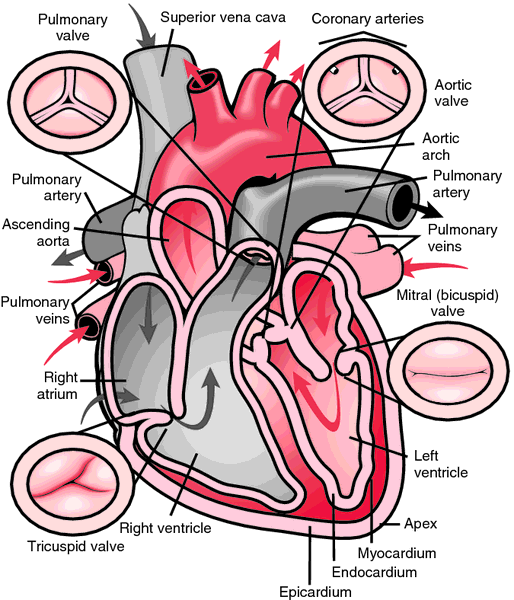valve
[valv]a membranous fold in a canal or passage that prevents backward flow of material passing through it.
aortic valve a semilunar valve that separates the left ventricle and the aorta; it opens with end diastole, causing the second heart sound.
atrioventricular v's the cardiac valves between the right atrium and right ventricle (tricuspid valve) and the left atrium and left ventricle (mitral valve).
bicuspid valve mitral valve.
bicuspid aortic valve a congenital anomaly of the aortic valve, caused by incomplete separation of two of the three cusps; it is generally asymptomatic early in life but is predisposed to calcification and stenosis later on.
Braschi valve a one-way valve put into the inspiratory limb of a ventilator circuit in order to measure the intrinsic positive end-expiratory pressure.
cardiac v's valves that control flow of blood through and from the heart.
coronary valve a valve at the entrance of the coronary sinus into the right atrium.
flail mitral valve a mitral valve having a cusp that has lost its normal support (as in ruptured chordae tendineae) and flutters in the blood stream.
heart v's cardiac valves.
Heimlich valve a small one-way valve used for chest drainage, emptying into a flexible collection device; the valve prevents return of gases or fluids into the pleural space. The Heimlich valve is less than 13 cm (5 inches) long and facilitates patient ambulation; it can be used in many patients instead of a traditional water seal drainage system.
ileocecal valve (ileocolic valve) the valve guarding the opening between the ileum and cecum.
mitral valve the cardiac valve between the left atrium and left ventricle, usually having two cusps (anterior and posterior). Called also bicuspid valve.

Valves of the heart. The right heart pumps the venous blood into the lungs. The oxygenated blood returns from the lungs into the left atrium and is propelled by the left ventricle into the aorta. The insets show closed valves: the tricuspid valve has three leaflets, whereas the mitral valve has two leaflets. The aortic and pulmonary artery valves have three leaflets and resemble one another except for the fact that the coronary arteries originate from behind the cusps in the aorta. From Damjanov, 1996.
posterior urethral valve any of various types of congenital folds across the proximal part of the male urethra near the seminal colliculus, the most common cause of urethral obstruction in male infants.
pulmonary valve (pulmonic valve) the pocketlike cardiac valve that protects the orifice between the right ventricle and the pulmonary artery.
pyloric valve a prominent fold of mucous membrane at the pyloric orifice of the stomach.
thebesian valve coronary valve.
tricuspid valve the cardiac valve guarding the opening between the right atrium and right ventricle.
valve of vein (venous v's) any of the small cusps or folds found in the tunica intima of many veins, serving to prevent backflow of blood.
Miller-Keane Encyclopedia and Dictionary of Medicine, Nursing, and Allied Health, Seventh Edition. © 2003 by Saunders, an imprint of Elsevier, Inc. All rights reserved.
ileal papilla
[TA]seen in the cadaver as a bilabial prominence of the terminal ileum protruding into the large intestine at the cecocolic junction; in a living person, it appears as a truncated cone with a star-shaped orifice.
Synonym(s): papilla ilealis [TA], Bauhin valve, ileocecal eminence, ileocecal valve, ileocolic valve, Tulp valve, Tulpius valve, valva ileocecalis, valve of Varolius
Farlex Partner Medical Dictionary © Farlex 2012
il·e·al or·i·fice
(il'ē-ăl ōr'i-fis) [TA]The opening of the terminal ileum into the large intestine at the transition between the cecum and the ascending colon.
Synonym(s): ileocecal valve, ileocolic valve, ileocolic vein, ostium ileale.
Synonym(s): ileocecal valve, ileocolic valve, ileocolic vein, ostium ileale.
Medical Dictionary for the Health Professions and Nursing © Farlex 2012
Bauhin,
Gaspard, Swiss anatomist, 1560-1624.Bauhin gland - one of the small mixed glands deeply placed near the apex of the tongue on each side of the frenulum. Synonym(s): anterior lingual gland
Bauhin valve - Synonym(s): ileocecal valve
Tulp,
Nicholas (Nicolaus Tulpius), Dutch anatomist, 1593-1674.Tulp valve - the bilabial prominence of the terminal ileum into the large intestine at the cecocolic junction as seen in cadavers. Synonym(s): ileocecal valve
Varolius,
Constantius (Costanzio), Italian anatomist and physician, 1543-1575.pons varolii - in neuroanatomy, the part of the brainstem between the medulla oblongata caudally and the mesencephalon rostrally. Synonym(s): pons
valve of Varolius - the bilabial prominence of the terminal ileum into the large intestine at the cecocolic junction as seen in cadavers. Synonym(s): ileocecal valve
Medical Eponyms © Farlex 2012